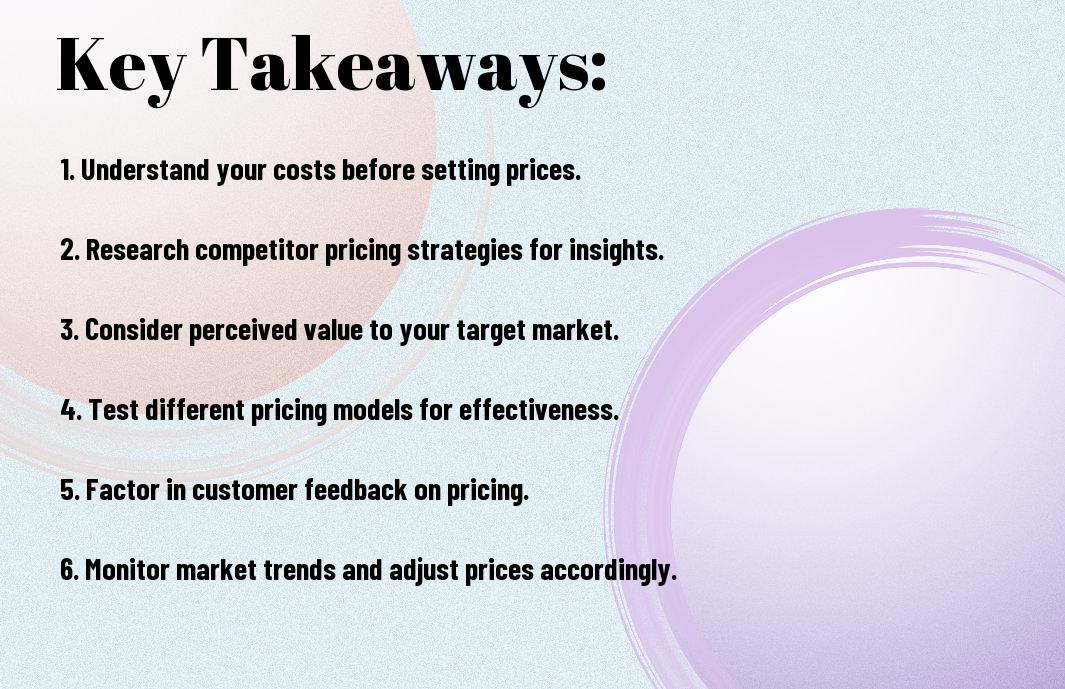It’s vital to find the right price point for your products to ensure your business thrives. Proper pricing not only influences customer behavior but also impacts your bottom line. In this post, you will learn various strategies to effectively price your products, balancing competitiveness with profitability. You’ll gain insights into market analysis, cost considerations, and psychological pricing techniques that can help you optimize your revenue and maximize your profit margins. Let’s examine the key components of pricing strategy that can elevate your business success.
Key Takeaways:
- Understand Costs: Calculate both fixed and variable costs to ensure that pricing covers all expenses.
- Market Research: Analyze competitors’ pricing strategies to position your products effectively within the market.
- Value Proposition: Communicate the unique value or benefits of your product to justify pricing and attract customers.
- Pricing Models: Explore different pricing models, like cost-plus, value-based, or dynamic pricing, to find the best fit for your business.
- Monitor Performance: Regularly assess your pricing strategy and adjust based on sales data and market trends to maximize profit.

Understanding Your Costs
While pricing your products, it’s imperative to have a clear understanding of your costs. Knowing what you spend on production, materials, labor, and other expenses will help you determine the right price point. This knowledge enables you to ensure that your product pricing reflects not only your overhead but also the desired profit margin, setting you up for long-term success in the market.
Fixed and Variable Costs
After you identify your costs, distinguish between fixed and variable expenses. Fixed costs remain constant regardless of the number of products you produce, such as rent and salaries. In contrast, variable costs fluctuate with production levels, including materials and labor directly associated with creating your products. Understanding these categories helps you form a comprehensive pricing strategy.
Total Cost Calculation
Against this backdrop, calculating your total costs is imperative for setting effective prices. Total costs are the sum of both fixed and variable expenses, and only by knowing this figure can you price your products accurately to ensure profitability.
For instance, if your fixed costs amount to $5,000 per month and your variable costs per unit are $10 with a planned production of 1,000 units, your total cost calculation will be imperative. Here, your total costs would be $5,000 (fixed) + $10,000 (variable for 1,000 units), giving you a total of $15,000. By dividing this total by the number of units, you see that you need to price each unit above $15 to achieve a profit. This approach highlights the importance of precise cost calculations in your pricing strategy.
Market Analysis
Any successful pricing strategy begins with a thorough market analysis. This means understanding the overall market trends, the demand for your product or service, and the economic factors that may influence your pricing choices. By analyzing market conditions, you’ll be better equipped to set a price that not only attracts customers but also maximizes your profit margins.
Competitor Pricing
Behind every effective price point is a keen understanding of what your competitors are charging. Evaluate their pricing strategy, including any discounts or promotions they offer. This information helps you position your product competitively, ensuring that your price reflects its true value while remaining attractive to potential customers.
Customer Perceptions
With the right insight into how customers perceive value, you can tailor your pricing to meet market expectations. Understanding customer perceptions means considering what features and benefits they prioritize, ensuring your price aligns with their expectations and perceived value of your product.
The way customers perceive your product can significantly influence their willingness to pay. When they see value in what you offer, they’re more likely to support your price point. This perception is often shaped by factors such as quality, brand reputation, and customer service. By enhancing these elements, you can elevate your product in the eyes of customers, allowing you to charge a premium price while sustaining customer loyalty.

Pricing Strategies
Your pricing strategy is crucial to maximizing profit and should align with your business goals. Depending on your target audience and market conditions, you may adopt different approaches such as cost-plus or value-based pricing. Understanding these strategies will empower you to set prices that not only cover costs but also enhance the perceived value of your products.
Cost-Plus Pricing
Before implementing a cost-plus pricing strategy, calculate the total costs involved in producing your product, including both fixed and variable expenses. Then, add a markup percentage to these costs to determine your selling price. This approach ensures that you cover your expenses while achieving a consistent profit margin, making it a straightforward method for establishing prices.
Value-Based Pricing
Along with considering your costs, value-based pricing focuses on the perceived value of your product in the eyes of your customers. This strategy allows you to set prices based on the benefits your product provides and what customers are willing to pay, rather than just your expenses. By understanding your clientele’s needs and preferences, you can leverage their willingness to pay a premium for features or advantages, ultimately driving greater profitability.
Pricing your products based on perceived value means conducting market research to identify customer desires and aligning your offerings accordingly. Highlight unique features, differentiators, and benefits that resonate with your audience. Educating your customers about what makes your product special can justify higher price points and foster loyalty, resulting in both increased sales and profit margins over time. This strategic approach enables you to capture a larger share of the market by presenting your pricing as a reflection of quality and value provided.
Implementing Discounts and Promotions
All businesses can benefit from strategic discounts and promotions to entice customers and increase sales. You may consider utilizing effective techniques as outlined in How to Price Your Product | CO to maximize your profit potential.
Types of Discounts
An effective discount strategy can encompass various types of offers that appeal to your customers:
| Type of Discount | Description |
| Percentage Off | A reduction based on a percentage of the regular price. |
| Buy One Get One | Incentivizes customers to purchase more by offering a second item free or at a discount. |
| Seasonal Sales | Discounts linked to specific events or seasons, boosting sales during peak times. |
| Limited-time Offers | Creates urgency for customers to purchase before the offer expires. |
| Membership Discounts | Establishes loyal customers through exclusive pricing. |
- Consider the impact on your profit margins.
- Evaluate customer responses to different types of discounts.
- Assess seasonal trends in your product category.
- Communicate offers effectively across marketing channels.
- Assume that the right discounts can drive sales and customer loyalty.
Timing and Strategy
Against all odds, strategically scheduling your promotions can significantly impact your sales. Timing them effectively can capture customer attention and boost your sales figures during peak buying periods.
Discounts should be utilized during specific times that align with your business goals and customer behavior. By analyzing past sales data and market trends, you can determine optimal times for offerings such as holidays or local events. Additionally, adapt your promotions based on customer feedback and shopping patterns to ensure they resonate with your audience and encourage repeat purchases.
Monitoring and Adjusting Prices
Keep a close eye on your pricing strategy by regularly assessing how your products are performing. This means tracking sales, analyzing customer feedback, and staying attuned to industry trends. By monitoring these factors consistently, you can make informed adjustments to your prices that align with your business goals and market demands.
Analyzing Sales Data
After collecting sales data, take the time to analyze it thoroughly. Look for patterns in purchasing behavior, assess which products are selling well and which are not, and identify seasonal trends. This analysis will help you understand how pricing affects demand and which adjustments might enhance your overall profitability.
Responding to Market Changes
Below are various strategies you can use to respond effectively to market changes. By keeping an eye on competitor pricing, shifts in consumer demand, and emerging trends, you can stay proactive rather than reactive in your pricing approach.
At the core of responding to market changes is the need to be agile. You should evaluate competitors’ pricing regularly to ensure your products remain competitive while also considering customer feedback to identify any evolving preferences. Additionally, economic conditions or seasonal influences can impact pricing strategies. By maintaining flexibility, you can adjust your prices as needed to optimize sales and maximize your profits in a changing marketplace.
Psychological Pricing Tactics
Once again, integrating psychological pricing tactics can significantly influence customer behavior and boost your profits. By utilizing strategies that tap into the emotions and perceptions of your target audience, you can create a stronger connection between the price and the value of your products. This not only encourages purchase decisions but also fosters brand loyalty, ultimately maximizing your overall revenue.
The Power of Pricing Psychology
An effective pricing strategy leverages the principles of pricing psychology, which suggests that the way you present prices can deeply affect customer perception. Customers often make decisions based on emotional responses rather than logical reasoning. By understanding these psychological triggers, you can position your products to appear more attractive and affordable, leading to increased sales and higher profits.
Price Anchoring Techniques
Anchoring is a powerful technique that influences your customers’ perception of value and fairness in pricing. By presenting a higher-priced item alongside a lower-priced option, you create a reference point that makes the latter seem more appealing. This strategy effectively guides your customers toward making a purchase and can ultimately enhance your bottom line.
At the heart of price anchoring techniques is your ability to establish a price reference that shapes customer expectations. For instance, if you offer a premium product priced at $200 next to a standard version at $100, the premium product sets an anchor that makes the standard option appear more reasonable and valuable. This comparative pricing method can stimulate consumer interest, making them more likely to purchase even if they initially intended to spend less. Carefully crafting your product lineup with strategic anchors can lead to significant increases in sales and profits.
Conclusion
Upon reflecting, pricing your products effectively is integral to achieving maximum profit. By understanding your costs, analyzing your target market, and employing pricing strategies like psychological pricing or value-based pricing, you can position your products optimally. Regularly reassess your prices in response to market conditions and customer feedback to maintain competitiveness. By implementing these practices, you can not only enhance your profit margins but also build lasting relationships with your customers.
Q: What factors should I consider when determining the price of my product?
A: When pricing your product, consider factors such as production costs, market demand, competitor pricing, and perceived value. Production costs include materials, labor, and overhead expenses. Market demand looks at how much customers are willing to pay based on trends and consumer preferences. Competitor pricing provides insight into how similar products are priced, and perceived value encompasses the brand reputation and quality of the product in the eyes of consumers.
Q: How can I effectively test different price points for my products?
A: To test different price points, you can utilize A/B testing, where you offer the same product at different prices to different segments of your audience. This method helps you analyze purchasing behavior and see which price point yields the highest sales volume and revenue. Additionally, consider limited time offers or seasonal pricing strategies to gauge customer response to various price levels without committing to a permanent change. Always track the results to adjust future pricing strategies effectively.
Q: What role does psychological pricing play in pricing my products?
A: Psychological pricing involves setting prices that have a psychological impact on consumers, such as pricing products at $9.99 instead of $10.00. This strategy can create the perception of a better deal, making customers more likely to make a purchase. Additionally, using charm pricing (ending prices in .99 or .95) can trigger impulse buys. Understanding how your target customers perceive price can aid in crafting pricing strategies that maximize profit while still making your products appealing.


